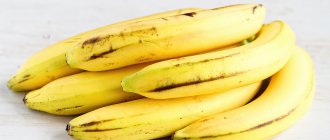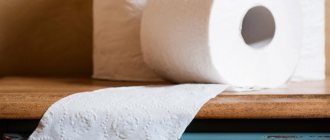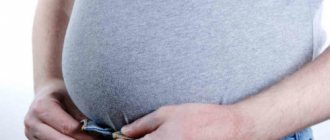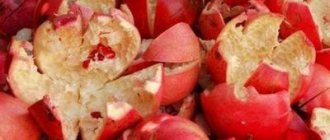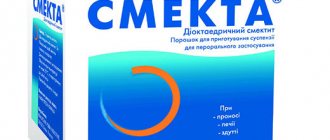Young mothers often encounter problems with their children’s bowel movements: diarrhea or constipation. Fatty stool in a child, the appearance of which can be caused by various factors, is called steatorrhea.
Normal stool
The nature and frequency of normal bowel movements in a breastfed baby depends on the individual characteristics of the body, but on average they have the following indicators:
- Frequency up to 8 times a day when breastfeeding;
- Feces should not contain mucus, lumps of food, and be homogeneous.
If there are greasy stains from feces on the diaper or diaper that become soapy when washed, it means that there is some kind of disorder in the baby’s body and an examination and qualified treatment is necessary.
Fatty stool, child does not have diarrhea
Hello! The child is 1 year 2 months old. Since birth, the child has had a stomach ache, profuse gas formation, the child is on guard. Born 3620, now weighs 9200. The pain is cramping, appetite is reduced, refuses to eat, constantly strains, tendency to constipation, pureed stool, defecation difficult Now she poops every day or every other day. I noticed that when she eats cottage cheese, the stool becomes greasy and is difficult to wash off from the butt. Weight gain by month: 1 month-900.2 month-700.3 month-500.4 month-300.5 month-500.6 month-500.7 month-300.8 month-200.9 month-300. 10th month - 300. 11th month - 300. 12th month - 200. 13th month - 200. 14th month - 300. For complementary foods, we eat dairy-free and gluten-free porridge, soups with meat and vegetables, applesauce, banana. The condition worsens with milk; for gluten, I also tried giving oatmeal and vermicelli broth (very little)!!!! When a child farts, he coughs for some reason, and pushes until his whole face turns red.
Causes of fatty stools in children
There are several main reasons why a child has oily, greasy stools:
- Impaired absorption of fats in the intestines due to congenital deficiency of the lipase enzyme.
- Fatty stools in infants can occur in premature babies with insufficient development of pancreatic functions.
- On artificial breastfeeding, the baby does not receive enough lipase (it is found in abundance only in breast milk).
- Impaired fat metabolism and biliary tract dysfunction.
- Celiac disease is an allergic disease that interferes with the absorption of gluten. Celiac disease has a genetic hereditary predisposition.
Fat in a child’s feces most often forms immediately after the introduction of cereal complementary foods into the diet. When fat appears in a baby's stool, it slows down in growth and weight gain, tearfulness and irritability occur.
Reasons for neutral fat in coprogram
When performing a stool analysis for coprogram, a quantitative and qualitative study of its parameters is performed.
Sand in the stool of a child under one year old - reasons for the appearance of dots and lumps
Qualitative fecal fat analysis involves counting the number of fat globules in the stool using a microscope. Two types of these pellets are measured: neutral fat and fatty acids.
Normal results:
- less than 60 globules of neutral fat;
- less than 100 – for fatty acids.
Quantitative analysis determines the fat value in grams over 24 hours. The norms for an infant are less than 1 g/24 hours:
- in children on breastfeeding, fat should make up from 30 to 50% of the sample;
- in infants under one year of age with artificial feeding - from 10 to 40% of the sample (small volume of feces).
Important! The presence of neutral fat in a child’s feces can not only be noticed under a microscope. In a child, fatty poop has identifiable external signs. They have a sticky clay-like structure and a sour-spicy smell.
Analysis of stool for coprogram
There are various reasons why fatty acids are present in a child's stool:
- Indigestion – no processing of fat in the intestines. Occurs due to a lack of bile acids and pancreatic enzymes;
- Poor absorption of fats in the intestines;
- Excessive fat consumption. This can happen in a baby if the mother's milk is very fatty.
Neutral fat in a baby’s feces can appear against the background of many pathologies:
- Diseases of the pancreas;
- Liver pathologies such as hepatitis, hemochromatosis (disturbance of metabolic processes associated with iron metabolism);
- Diseases of the gallbladder and ducts;
- Crohn's disease (chronic inflammation of the intestinal tract);
- Diverticulosis is a pathological process accompanied by the appearance of protrusions (diverticula) in the intestinal wall;
- Enterita;
- Lactose intolerance;
- Celiac disease (an immune disease associated with a lack of enzymes that break down gluten);
- Dysbacteriosis, a possible cause of which may be treatment with antibiotics;
- The presence of parasites in the body.
Important! The baby may experience a lack of enzymes necessary for the normal functioning of the digestive system due to its immaturity. Typically, once most babies reach 4 months of age, the problems disappear.
Classification
Based on the causes and nature of the disease, fatty stools in infants have several main types:
- Pancreatic diarrhea occurs due to pancreatic dysfunction and lack of lipase.
- Intestinal steatorrhea occurs when the intestinal mucosa is damaged and the process of absorption of beneficial elements is disrupted.
- Food diarrhea is caused by the inability to digest excess fats.
Depending on the nature of its manifestation, diarrhea can be of three types:
- Neutral fats are present in feces.
- The presence of soaps and fatty acids in bowel movements.
- Mix the type of acids in the stool.
Types of steatorrhea
There are several types of pathology.
The classification depends on what type of fat was found in the stool and the disease that caused this pathology:
- Nutritional (food) steatorrhea. The laboratory technician may detect undigested fat in the stool. This pathology occurs with excessive consumption of fatty, high-calorie foods.
- Intestinal steatorrhea is characterized by the presence of mixed fats in the stool. The disease occurs against the background of intestinal pathologies, with the development of inflammation, when nutrients are not absorbed in the small intestine.
- Pancreatic steatorrhea is characterized by the release of neutral fats (more than 7 g) along with feces. Pathology occurs when the pancreas secretes insufficient amounts of enzymes. In this case, ultrasound and blood tests are not informative. The pathology of the pancreas can only be determined by the coprogram of stool; if a lot of fat is found in it, it is not difficult to determine the disease.
A doctor can make an accurate diagnosis after laboratory tests of stool. The purpose of the test is to find saponified fats in feces.
Diagnosis of causes
When fat is observed in a child’s stool, it is necessary to contact a gastroenterologist, who will first of all rule out a violation of the digestion of fats as the cause of the disease. For this purpose, a set of primary studies is prescribed:
- Study of feces (scatological analysis);
- Liver check;
- Examination of the pancreas;
- Immunological analysis;
- Biochemical tests;
- Ultrasound.
Most often, tests for fatty stool in breastfed infants are carried out in a hospital setting.
Causes
Fats (lipids) from food are digested in the intestines under the action of the enzyme lipase, produced mainly in the pancreas. Congenital lipase deficiency sometimes occurs , but in newborns this deficiency is more often temporary, associated with immaturity of the pancreas . As a result of this immaturity, the production of enzymes, including lipase, is insufficient. This deficiency occurs especially often in premature infants and children with intrauterine growth retardation.
Meanwhile, nature has foreseen this situation and provided babies with reliable insurance: breast milk contains lipase, which facilitates the digestion of fats. However, if the baby is formula-fed, pancreatic lipase immaturity may manifest itself clinically.
In addition to lipase, a certain composition of bile is required for the digestion of fats, so disorders of fat metabolism can also be observed in children with diseases of the liver and biliary tract . Such diseases are characterized by not just fatty, but also lighter-than-usual stools.
Treatment of fatty stool in a child
Therapeutic measures are aimed not only at combating symptoms; in order to eliminate diarrhea, it is necessary to identify the cause and treat it.
Drug therapy
The basis of therapy is taking lipase drugs to improve the functioning of the digestive system:
- "Pancitrate";
- "Creon";
- "Pancreatin".
Additionally, the newborn will take antacid medications:
- "Gastal";
- "Maalox";
- "Almagel";
- "Phosphalugel".
These appointments are aimed at neutralizing the effect of gastric juice.
Enzyme therapy helps to effectively treat fatty diarrhea in children. Qualified specialists prescribe for children:
- Oral intake of hydrochloric acid;
- Intravenous administration of cortisone and adenocorticosteroids.
When observing fat in a baby's stool, in addition to therapeutic treatment, it is necessary to maintain a dietary diet and include foods rich in complete proteins.
What is steatorrhea
Steatorrhea is the release of fat from the human body along with feces. Fatty acids entering the human body are absorbed by 98%. If this does not happen, pathology of internal organs or excessive consumption of fatty foods is suspected.
The digestive system simply cannot cope with so many fatty acids. If a baby has fats or soap in their stool, a problem with the pancreas is suspected.
Another reason may be excessively fatty breast milk.
How to accurately determine the cause of the disease
At the first visit, the doctor palpates the abdomen. When you press on it in the lower left part, you can hear a rumbling sound, the sound of iridescent liquid.
After the examination, the following types of diagnostics are prescribed:
- Rectoscopy is an examination of the rectum with an endoscope (up to 30 cm). Allows you to identify swelling, atrophy, ulceration of the intestinal mucosa.
- Colonoscopy is a complete examination of the intestines. Allows you to identify pathologies in all areas.
- Biopsy is the removal of affected organ cells for examination. Allows you to confirm or exclude cancer.
- Coprogram (stool microscopy) allows you to identify drops of fat and fatty acids in the stool and determine at what stage the disease is.
- Ultrasound of the digestive organs. Identifies pathologies of internal organs.
- MRI is used if ultrasound examination turns out to be uninformative. Allows you to identify any pathologies and neoplasms.
- A blood test shows an increase in leukocytes and ESR. This is typical for this disease.
The doctor determines what type of diagnosis to prescribe depending on the suspicion of a particular pathology.
Additional measures
To normalize digestion and improve bowel movements, during treatment the child must follow a special diet with a high protein content. Before starting, you should take a urine test and evaluate your kidney function, since disturbances in the functioning of the renal system can lead to proteinuria. If the child is healthy, it is recommended to increase the proportion of protein foods in the diet by about 10-15%. Boiled meat and fish, meat casseroles and souffles, eggs (it is better to choose quail eggs - they have less cholesterol), cottage cheese, and dairy products are useful for children with signs of steatorrhea.
If the child is not prone to intestinal disorders, you can give plant foods rich in proteins: chickpeas, beans, lentils. These products belong to legumes and contain a large amount of puric acid, which, when broken down, forms purines and causes bloating and flatulence, so it is better for children prone to colitis and enteritis to consume animal proteins.
Lentils
Products that irritate the intestinal mucosa should be completely excluded from the diet.
Sample menu for children who have neutral fats in their stool
Breakfast:
- steamed scrambled eggs with herbs, tomatoes and pieces of boiled chicken;
- whole grain toast;
- tomato juice.
Lunch:
- cottage cheese casserole with apples.
Cottage cheese casserole
Dinner:
- meat broth with meatballs and crackers;
- mashed potatoes with beef cutlet;
- compote.
Afternoon snack:
- natural thick yogurt without sugar;
- marshmallows;
- black tea.
Marshmallow
Dinner:
- fish stew with a side dish of vegetables;
- lingonberry juice.
Before bedtime:
- a glass of milk or kefir.
A glass of milk





